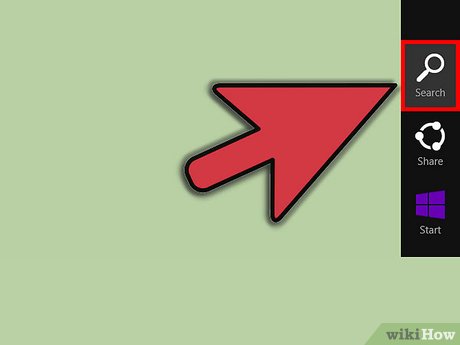How to Set Program Access in Windows 8
Method 1 of 2:
Opening the Program Access Menu
-
 Open the search menu.
Open the search menu.- In this section, we'll use Windows 8's search function to get to the Program Access menu quickly. Start by bringing up the search bar. There are a few ways to do this:
- Move your mouse to the very top right corner of the screen. Leave it still for a second or two and a menu should pop in from the right side of the screen. Click the magnifying glass icon.
- If you have a touchscreen monitor, just swipe inward from the right side of the screen and tap on the magnifying glass icon.
- Alternatively, bring up the Start screen (click the Windows icon in the taskbar, which is in the bottom left by default) and click the small magnifying glass in the top right.
- Note: If you don't usually have a hard time finding things on Windows 8, you can skip this section and simply find the Program Access Menu under Control Panel>All Control Panel Items>Default Programs.
- In this section, we'll use Windows 8's search function to get to the Program Access menu quickly. Start by bringing up the search bar. There are a few ways to do this:
-
 Type "default programs" into the search bar.
Type "default programs" into the search bar.- A list of related options should pop up. Select the "Default Programs" option that should be at the top of the list.
- If you can't find the "Default Programs" option, you can search for "Control Panel", select the Control Panel option, click "Program," and finally click "Default Programs" to get to the same location.[1]
-
 Select "Set program access and computer defaults."
Select "Set program access and computer defaults."- This option is listed at the bottom of the Default Programs screen.
Method 2 of 2:
Changing Program Access Options
-
 Click on the "Custom" option.
Click on the "Custom" option.- Under "Choose a configuration:", you'll see three options: Microsoft Windows, Non-Microsoft, and Custom. These options give you different choices for how to assign access to the programs on your computer. To choose your own rules, select Custom.
-
 Uncheck the "Enable access to this program" boxes to disallow programs.
Uncheck the "Enable access to this program" boxes to disallow programs.- In this menu, you'll see a list of commonly-used programs. To the right of each is a check box. Uncheck each box to restrict access to the corresponding program.
- Once a box is unchecked, the program will cease to appear in the Start menu and most other places where it previously would have appeared. However, this will not uninstall the program.
-
 Click the bubbles to set default programs.
Click the bubbles to set default programs.- In the Program Access menu, you can also choose which of the programs that you do have enabled will be your default. To do this, simply click the circular "bubble" to the left of the appropriate program.
- A default program is the program that Windows will automatically use for reading certain types of files. For instance, if you have Windows Media Player set as your default media player, if you double click a song or movie on your computer, it will launch in Windows Media Player.[2]
-
 Click "OK" to save your changes.
Click "OK" to save your changes.- The "OK" button is at the bottom of the window next to the "Cancel" and "Help" buttons. Your changes will take place immediately.
-
 Re-check the boxes to allow access to programs.
Re-check the boxes to allow access to programs.- If at any point you want to make a program that you've disallowed accessible again, simply return to the Program Access menu and re-check its box.
- Click "OK" to re-save your changes.
4.5 ★ | 2 Vote








 How to Use Narrator on Windows 8.1
How to Use Narrator on Windows 8.1 How to Print in Windows 8
How to Print in Windows 8 How to View PDF and XPS Files in Windows 8.1 with Reader App
How to View PDF and XPS Files in Windows 8.1 with Reader App How to Control Windows 8 Startup Programs
How to Control Windows 8 Startup Programs How to Add Start Tiles to the Taskbar in Windows 8
How to Add Start Tiles to the Taskbar in Windows 8 How to Restore Start Button in Windows 8
How to Restore Start Button in Windows 8